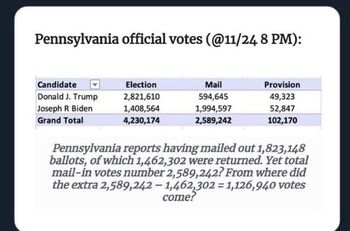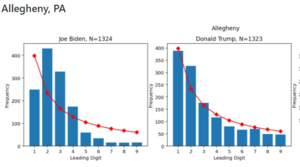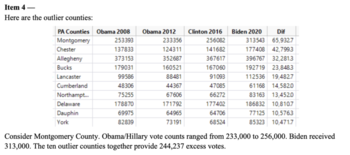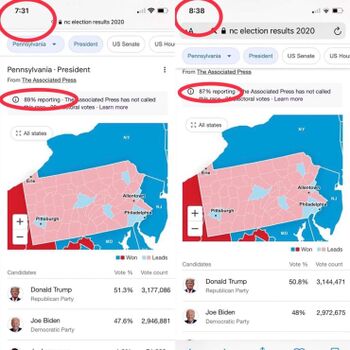Pennsylvania election fraud
 From Conservapedia - Reading time: 12 min
From Conservapedia - Reading time: 12 min
- See also: Democrat election fraud and Biden Putsch
The Pennsylvania state legislature decided Election Day ends at 8 PM on November 3, 2020 election night. Rogue Democrat governor Tom Wolf circumvented the state legislature and took the fight to the state supreme court. The Pennsylvania Supreme Court created law out of thin air and extended the deadline for mail-in ballots to November 6. The case then was appealed to the U.S. Supreme Court.
No signature verification was done in 2020 in Pennsylvania on any of the 2.6 million mail-in ballots, when the rejection rate on such ballots in 2020 was only 1.3%[1] (probably due to entirely missing signatures) while the rejection rate has been as high as 4.5% in prior elections.
By 2022, there were more than 10,000 locations in Pennsylvania, mostly unsecured drop boxes, which accepted ballots without verification.[2]
Contents
- 1 Illegal instructions from the Secretary of Commonwealth
- 2 Ignoring mail-in ballot safeguards
- 3 PA Facebook illegal funding
- 4 Confusing guidance
- 5 Trashed Trump military ballots
- 6 Extra ballots
- 7 Unsecured voting
- 8 New Jersey voters
- 9 Changing votes for Trump
- 10 Mis-addressed ballots
- 11 Naked ballots in Philadelphia
- 12 Ballot dump
- 13 682,770 estimated ballots processed with no observers
- 14 Violations of the equal protection
- 15 No down ballot voting
- 16 Dead people voting
- 17 Dominion Election Systems
- 18 See also
- 19 References
- 20 External links
Illegal instructions from the Secretary of Commonwealth[edit]
Democrat operative Kathy Boockvar, who simultaneously was serving as Pennsylvania Secretary of Commonwealth in charge of elections, told the United States Supreme Court on October 28, 2020 that ballots received after 8 p.m. on November 3, 2020 would be segregated, but she changed the rules on November 1 and directed counties to canvass those ballots as soon as possible upon receipt. In some counties, it is not possible to both segregate and canvass ballots as directed. This directive leaves open the possibility that timely votes will be commingled with votes received after 8 p.m. on Election Day, despite the fact that these votes remain the subject of litigation before the United States Supreme Court.
The Department changed the rules again on November 2, 2020 when they provided last-second guidance directing counties to provide information to help voters whose mail-in or absentee ballots were incorrectly completed so those voters could vote on a provisional ballot. The late release of this “guidance” resulted in inconsistent application across the counties – some of whom contacted voters as directed and some who did not. There is no basis for this guidance in current law. The Secretary created this new process out of thin air.
At 8:38 p.m. on Monday, November 2 – less than 12 hours before the polls were to open – the Department issued an email to counties directing them to provide information to political party and candidate representatives regarding mail-in and absentee ballots which had been set aside because they failed to comply with the requirements of the Election Code in order to be counted, so that voters could come in and vote provisionally at the polls. The late release of this “guidance” resulted in inconsistent application across the counties, some of whom contacted voters as directed and some who did not; such differential treatment is wholly inappropriate and a direct result of Boockvar’s scattershot approach to Pennsylvania’s elections.[3][4]
Ignoring mail-in ballot safeguards[edit]

Boockvar and the county officials repeatedly ignored essential safeguards for absentee and mail-in voting which require “procedural safeguards to deter fraud and ensure transparency” due to “inherent risk.” In December 2019, Pennsylvania’s auditor general, Eugene DePasquale, determined that there are more than 50,000 cases of potentially inaccurate voter records in the state’s system.
On October 31, 2019, Pennsylvania’s legislature passed Act 77, which allowed all Pennsylvania voters the option of voting by mail without providing a reason or excuse. Yet mail-in voting still requires a ballot application and the election code still bars ballot harvesting except in the case of disabled voters. Pennsylvania law still requires ballots that have been filled out incompletely or incorrectly to be declared void and it does not permit election boards to give voters who cast improper ballots a “notice and opportunity to cure” those ballots.
Importantly, Act 77 prohibits a voter from casting both a mail-in ballot and an in-person ballot, unless the voter returns an unvoted mail-in ballot and declares that he or she has not voted by mail. The lawsuit alleged,
| “Defendants failed to take adequate measures to ensure that the provisions of the Election Code enacted to protect the validity of absentee or mail-in ballots, including without limitation Act 77, were followed.” |
PA Facebook illegal funding[edit]
Urban counties such as Allegheny (Pittsburgh), Philadelphia, and Delaware County received over $10 million in private grants that imposed strict conditions on the conduct of elections without legislative approval, violating state laws prohibiting the use of private money to pay for federal elections.
Documents obtained through court order revealed communication between the City of Philadelphia and the Center for Technology and Civic Life (CTCL) emphasizing that CTCL paid election judges in Philadelphia and other election officials. CTCL mandated Philadelphia to increase its polling locations and to use drop boxes and eventually mobile pick-up units. Moreover, Facebook CEO Mark Zuckerberg monies allowed Philadelphia to “cure” absentee ballots in a manner not provided for in Republican areas of the state.
In Democrat Delaware County, Pennsylvania, one drop box was placed every four square miles and for every 4,000 voters. In the 59 counties carried by Trump in 2016, there was one drop box for every 1,100 square miles and every 72,000 voters. Government using public or private funding to facilitate a targeted demographic to turn out the vote while targeting another demographic to suppress the vote is an equal rights violation of the l4th Amendment. This two-tiered election system allowed voters in Democrat strongholds to stroll down the street to vote while voters in Republican strongholds were ignored and left in the dark.
Confusing guidance[edit]
On August 19, 2020, Secretary Boockvar sent all the 67 county election boards a guidance document claiming that the “naked ballots should be counted pursuant to the Pennsylvania Election Code.” (A ballot is considered “naked” if it is not returned in the secrecy envelope, as required by state law.)
On September 17, the Pennsylvania Supreme Court rejected that position, but Boockvar did not send follow-up guidance telling the election boards that they must not count naked mail-in ballots.
On September 11, Boockvar’s office sent the county officials another guidance regarding applications for mail-in ballots. That guidance did not mention the key fact that state law requires a voter to sign a mail-in ballot application, and the law requires officials to verify that signature before sending out a ballot.
The lawsuit claims the September 11 guidance forbade signature verification in vetting mail-in ballots and ballot applications. It also cites a September 28 guidance memo, in which Boockvar claimed that the “Election Code does not permit county election officials to reject applications or voted ballots based solely on signature analysis.” The lawsuit claimrf:
| “Despite the fact that well over a third of the votes were cast by mail, Secretary Boockvar and the Pennsylvania Department of State did not undertake any meaningful effort to prevent the casting of illegal or unreliable absentee or mail-in ballots and/or to ensure the application of uniform standards across the County Election Boards to prevent the casting of such illegal or unreliable ballots. Rather, Secretary Boockvar has exercised every opportunity to do quite the opposite.” |
Trashed Trump military ballots[edit]
Officials in Luzerne County found that a temporary seasonal election worker trashed nine military ballots received in unmarked envelopes, seven of which had been cast for President Trump.
Extra ballots[edit]
During the election, voters reported receiving mail-in ballots even though they did not apply for them. Many reported having received multiple mail-in ballots, some as many as four or five.
“Moreover, at the polling locations on Election Day, voters were informed that they must vote provisionally because they had applied for mail-in votes, even though those voters report that they neither applied for nor received mail-in ballots,” the lawsuit notes.
Some voters reported having received unsolicited mail-in ballots, but when they went to their in-person polling places, the poll books reflected that no mail-in ballot had been sent.
On the other hand, even though poll workers told voters that they were recorded as having already voted by mail, the workers let the voters cast ballots in person to be recorded on ballot machines.
Poll watchers reportedly observed poll workers mishandling spoiled mail-in or absentee ballots that should have been voided after the voters returned them in order to vote in-person instead.
Unsecured voting[edit]

In Allegheny County, voters reported that poll workers watched voters cast provisional ballots in such a way that the poll worker could determine which candidate the voter had selected.
New Jersey voters[edit]
In Centre County, a poll worker reported that people who identified themselves as New Jersey voters — rather than Pennsylvania voters — were allowed to cast provisional ballots in person.
Changing votes for Trump[edit]
In Chester County, an observer claimed to have witnessed an election worker alter the results of unclear ballots. The worker dealt with over-voted and under-voted ballots — ballots that marked either zero candidates or multiple candidates for one or more offices. “The observer reports that in numerous instances the election worker altered the over-voted ballot by changing votes that had been marked for Donald J. Trump to another candidate.”
Mis-addressed ballots[edit]
The lawsuit claims that| “dozens of mail-in ballots were addressed to single addresses, each ballot being in a different name. Based on the carrier’s experience delivering mail to those addresses, the carrier is aware that the people whose names were on the ballots are not names of people who live at those addresses. In addition, ballots were mailed to vacant homes, vacation homes, empty lots, and to addresses that do not exist.” |
Naked ballots in Philadelphia[edit]
Although local officials and celebrities engaged in media campaigns to encourage voters to send in their ballots in the secrecy envelope, some Pennsylvania counties reached out to voters after they had cast naked ballots.
Philadelphia County reportedly sent a “notification” to voters who had cast inadequate ballots, urging them to “cure” the ballots. “To figure out which voters should be notified, Philadelphia County had to inspect the mail-in ballots before election day—in plain violation of state law,” the lawsuit alleges.
Other counties — such as Lancaster, York, Westmoreland, and Berks Counties — “did not contact voters who submitted defective ballots or give them an opportunity to cure. They simply followed the law and treated these ballots as invalid and refused to count them.”
| “Because the counties that followed state law and did not provide a cure process are heavily Republican (and counties that violated state law and did provide a cure process are heavily Democratic), Defendants’ conduct harmed the Trump Campaign. It deprived the President of lawful votes and awarded his opponent with unlawful votes.” |
Ballot dump[edit]
Trump led by almost 800,000 votes on election night after most Americans headed to bed. Over the course of the next 72 hours, President Trump’s lead shrunk to less than a 95,000 vote lead in the keystone state, and then Joe Biden took the lead. Batches of votes started flowing into the final tally, mostly in favor of Joe Biden. Five Thirty Eight reported that “Two more batches of Pennsylvania vote were reported: 23,277 votes in Philadelphia, all for Biden."
The Pennsylvania Appeals Court issued an order that said
| “effective immediately … all candidates, watchers, or candidate representatives [shall] be permitted to be present for the canvassing process … and be permitted to observe all aspects of the canvassing process within 6 feet, while adhering to all COVID-19 protocols, including, wearing masks and maintaining social distancing.”[7] |
Philadelphia Democrat election officials refused to comply with the order,[8][9] and the Democrat Sheriff, a Biden supporter, refused to enforce the Appeals Court order.[10]
The Trump campaign then filed a lawsuit in federal district court claiming that the Board of Elections is “nonetheless continuing to count ballots, without any observations by any representatives or poll watchers of President Trump and the Republican Party.”[11]
115% of Pensylvania registered Democrats voted for Biden. Biden received 1.24 to 1.43 times greater than either Hillary Clinton or Barack Obama in predominant Republican counties.[12]
682,770 estimated ballots processed with no observers[edit]

The Pennsylvania Appeals Court issued an order that said
| “effective immediately … all candidates, watchers, or candidate representatives [shall] be permitted to be present for the canvassing process … and be permitted to observe all aspects of the canvassing process within 6 feet, while adhering to all COVID-19 protocols, including, wearing masks and maintaining social distancing.”[14] |
Philadelphia Democrat election officials refused to comply with the order,[15][16] and the Democrat Sheriff, a Biden supporter, refused to enforce the Appeals Court order.[17]
The Trump campaign then filed a lawsuit in federal district court claiming that the Board of Elections is “nonetheless continuing to count ballots, without any observations by any representatives or poll watchers of President Trump and the Republican Party.”[18] The lawsuit claims that Trump campaign observers were denied access altogether in some instances in Philadelphia County. The county’s elections board did not permit the Trump campaign’s observers to be within 6 feet of “all aspects” of the pre-canvassing process in violation of Commonwealth Court Judge Christine Fizzano Cannon’s November 5, 2020, order requiring that poll-watchers “be permitted to observe all aspects of the canvassing process within 6 feet.” The lawsuit states,
| “It is estimated that 680,770 ballots were processed by the Allegheny and Philadelphia County Boards of Elections when no observation was allowed.” |
115% of Pennsylvania registered Democrats voted for Biden. Biden received 1.24 to 1.43 times greater than either Hillary Clinton or Barack Obama in predominant Republican counties.[19]
The lawsuit cites many examples in which election officials prevented poll-watchers from observing the counting of votes, as required by state law.
Violations of the equal protection[edit]
Republican candidates and officials also filed a lawsuit challenging Montgomery county officials’ decision to notify voters whose ballots are defective and giving them a chance to “cure” the defects—something not authorized under state law.failing to maintain accurate voter rolls and remove individuals who have died, moved out of state, or otherwise become ineligible to vote.[20]
Tyler O'Neil of PJMedia reported Boockvar was sued by the 2020 Trump campaign following massive allegations of widespread voter fraud after the 2020 Presidential election, accusing Boockvar and county elections boards throughout the state of violating the U.S. Constitution by unilaterally revising the law in a manner that deprives some voters of their rights to a free and fair election. The lawsuit brought no fewer than seven counts against Boockvar and the county election officials, claiming that they violated the Fourteenth Amendment to the Constitution and the Electors and Elections Clauses of Article I in the Constitution. In broad strokes, the lawsuit accuses the defendants of unilaterally making law on elections, depriving the legislature of its rights, and of denying voters and the Trump campaign equal protection under the law. [21]
| “In a rush to count mail ballots and ensure Democrat Joe Biden is elected, Pennsylvania has created an illegal two-tiered voting system for the 2020 General Election, devaluing in-person votes.”
“For voters that appeared at the polls, those citizens were required to sign voter registrations, have those signatures checked against voter rolls, vote in a polling place monitored by statutorily-authorized poll observers, and have their votes counted in a transparent and verifiable open and observed manner. By contrast, due to the arbitrary, unauthorized, and standardless actions of the Secretary of the Commonwealth of Pennsylvania, Kathy Boockvar, nearly 2.65 million votes were cast through a ‘mail-in’ process that lacked all of the hallmarks of transparency and verifiability that were present for in-person voters.” |
The Trump campaign and two Pennsylvania voters allege that Boockvar
| “refused to require adequate verification of the voter’s identity. Rather than require votes to be received on the day of election, the Secretary permitted ballots received up to three days after the election to be counted without any evidence of timely mailing, such as a postmark. Finally, contrary to the in-person voting that is open and transparent to the parties and the candidates, Defendants permitted the review and counting of mail-in ballots largely in secret with no monitoring.”
“This two-track election system not only violates Plaintiffs’ rights guaranteed by the United States Constitution but also violates the structure of the Constitution that elections in the States must be carried out as directed by their respective legislatures.” |
The lawsuit seeks an emergency order preventing Pennsylvania from certifying the election results or one prohibiting the election officials from certifying any results
| “that include the tabulation of absentee and mail-in ballots which do not comply with the Election Code,” |
such as ballots counted while the Trump campaign’s watchers were prevented from observing or ballots that lack requirements of state law such as a secrecy envelope or a voter’s signed declaration. The lawsuit also seeks an injunction ordering election officials not to count ballots in cases where election officials contacted voters to give them an opportunity to “cure” improperly cast ballots.
This extraordinary legal action only makes sense given the numerous significant concerns the Trump campaign raises throughout the lawsuit. Boockvar and county election officials allegedly engaged in egregious discrimination and gave wanton preference to voters in Democratic-leaning counties over those in Republican-leaning counties.
No down ballot voting[edit]
Another way to track fraudulent votes is to look closely at how many of the votes did little or no down-ticket voting. When manufacturing votes, it is too time consuming to vote for other officeholders.[22]
Dead people voting[edit]
A lawsuit filed by the Public Interest Legal Foundation (PILF) alleges that there are at least 21,000 dead people on Pennsylvania’s voter rolls.[23] The lawsuit claims that Pennsylvania failed to “reasonably maintain” their voter registration records under federal and state law in time for the 2020 presidential election. The lawsuit states:
| “As of October 7, 2020, at least 9,212 registrants have been dead for at least five years, at least 1,990 registrants have been dead for at least ten years, and at least 197 registrants have been dead for at least twenty years."[24] |

According to the lawsuit, about 92 percent of the 21,000 dead people on Pennsylvania’s voter rolls died sometime before October 2019. About 216 dead people show voting credits after federally listed dates of death in 2016 and 2018, the lawsuit alleges.
Republican candidates and officials also filed a lawsuit challenging Montgomery county officials’ decision to notify voters whose ballots are defective and giving them a chance to “cure” the defects—something not authorized under state law.failing to maintain accurate voter rolls and remove individuals who have died, moved out of state, or otherwise become ineligible to vote.[25]
Dominion Election Systems[edit]
Russell Ramsland of Allied Security Systems confirms that data breaches in the Dominion Election Systems software permitted rogue actors to penetrate and manipulate the software during the recent general election. He further concludes that at least 96,600 mail-in ballots were illegally counted as they were not cast by legal voters.
See also[edit]
References[edit]
- ↑ https://ballotpedia.org/Election_results,_2020:_Analysis_of_rejected_ballots
- ↑ https://www.pasenategop.com/blog/senate-votes-to-ban-unsecured-ballot-drop-boxes-and-private-funding-of-election-operations/
- ↑ https://www.breitbart.com/politics/2020/11/04/pennsylvania-republican-senators-call-on-pa-secretary-of-state-to-resign/
- ↑ https://www.bitchute.com/video/xUWA4CqzQ6pN/
- ↑ https://youtu.be/2AYSs77k2tY
- ↑ https://epochtimes.today/statistical-anomalies-in-biden-votes-analyses-indicate/
- ↑ https://twitter.com/ZoeTillman/status/1324376367916605447
- ↑ https://www.breitbart.com/politics/2020/11/03/the-steal-is-on-in-pennsylvania-poll-watchers-denied-access-illegal-campaigning-at-polling-locations/
- ↑ https://www.lifesitenews.com/news/gop-poll-watchers-are-denied-access-in-philadelphia
- ↑ https://nationalfile.com/what-are-you-hiding-trump-campaign-says-philly-sheriff-wont-enforce-order-allowing-gop-observers/
- ↑ https://assets.documentcloud.org/documents/7325351/11-5-20-Trump-Campaign-v-Philadelphia-Board-of.pdf
- ↑ https://twitter.com/RaheemKassam/status/1325193658170134531
- ↑ file:///C:/Users/Owner/Downloads/483437334-PA-Voter-Analysis-Young.pdf
- ↑ https://twitter.com/ZoeTillman/status/1324376367916605447
- ↑ https://www.breitbart.com/politics/2020/11/03/the-steal-is-on-in-pennsylvania-poll-watchers-denied-access-illegal-campaigning-at-polling-locations/
- ↑ https://www.lifesitenews.com/news/gop-poll-watchers-are-denied-access-in-philadelphia
- ↑ https://nationalfile.com/what-are-you-hiding-trump-campaign-says-philly-sheriff-wont-enforce-order-allowing-gop-observers/
- ↑ https://assets.documentcloud.org/documents/7325351/11-5-20-Trump-Campaign-v-Philadelphia-Board-of.pdf
- ↑ https://twitter.com/RaheemKassam/status/1325193658170134531
- ↑ https://www.heritage.org/crime-and-justice/commentary/what-know-about-litigation-being-waged-across-us-preserve-trump
- ↑ https://pjmedia.com/election/tyler-o-neil/2020/11/10/10-reasons-pennsylvanias-election-results-may-be-irredeemably-compromised-n1136044
- ↑ https://thenationalpulse.com/politics/pennsylvania-vote-anomalies/
- ↑ https://andmagazine.com/talk/wp-content/uploads/2020/11/Reduced_WA-PA-Deceased-Voters-1.pdf
- ↑ https://theredelephants.com/there-is-undeniable-mathematical-evidence-the-election-is-being-stolen/
- ↑ https://www.heritage.org/crime-and-justice/commentary/what-know-about-litigation-being-waged-across-us-preserve-trump
External links[edit]
| ||||||||||||||||||||
 KSF
KSF